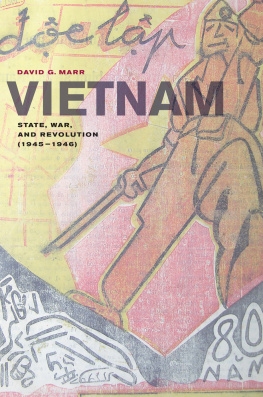
A

BOOK
The Philip E. Lilienthal imprint honors special books in commemoration of a man whose work at University of California Press from 1954 to 1979 was marked by dedication to young authors and to high standards in the field of Asian Studies. Friends, family, authors, and foundations have together endowed the Lilienthal Fund, which enables UC Press to publish under this imprint selected books in a way that reflects the taste and judgment of a great and beloved editor.
Vietnam
From Indochina to Vietnam: Revolution and War in a Global Perspective
Edited by Fredrik Logevall and Christopher E. Goscha
Assuming the Burden: Europe and the American Commitment to War in Vietnam, by Mark Atwood Lawrence
Indochina: An Ambiguous Colonization, 18581954, by Pierre Brocheux and Daniel Hmery
Vietnam 1946: How the War Began, by Stein Tnnesson
Imperial Heights: Dalat and the Making and Undoing of French Indochina, by Eric T. Jennings
Catholic Vietnam: A Church from Empire to Nation, by Charles Keith
Vietnam: State, War, and Revolution (19451946), by David G. Marr
Vietnam
State, War, and Revolution
(19451946)
David G. Marr

UNIVERSITY OF CALIFORNIA PRESS
BerkeleyLos AngelesLondon
University of California Press, one of the most distinguished university presses in the United States, enriches lives around the world by advancing scholarship in the humanities, social sciences, and natural sciences. Its activities are supported by the UC Press Foundation and by philanthropic contributions from individuals and institutions. For more information, visit www.ucpress.edu.
University of California Press
Berkeley and Los Angeles, California
University of California Press, Ltd.
London, England
2013 by The Regents of the University of California
Ch 3 is reprinted by permission of the publisher from Creating Defense Capacity in Vietnam, 19451947 in THE FIRST VIETNAM WAR: COLONIAL CONFLICT AND COLD WAR CRISIS, edited by Mark Atwood Lawrence and Fredrik Logevall, pp. 74101, Cambridge, Mass.: Harvard University Press, Copyright 2007 by The President and Fellows of Harvard College.
Library of Congress Cataloging-in-Publication Data
Marr, David G.
Vietnam: State, War, and Revolution (19451946) / David G. Marr.
p. cm.
Includes bibliographical references and index.
ISBN 978-0-520-27415-0 (cloth : alk. paper)
eISBN 9780520954977
1. Vietnam (Democratic Republic)History. 2. Indochinese War, 19461954. I. Title.
DS560.6.M37 2013
959.7041dc23
2012036193
Manufactured in the United States of America
22 21 20 19 18 17 16 15 14 13
10 9 8 7 6 5 4 3 2 1
In keeping with a commitment to support environmentally responsible and sustainable printing practices, UC Press has printed this book on Rolland Enviro 100, a 100% post-consumer fiber paper that is FSC certified, deinked, processed chlorine-free, and manufactured with renewable biogas energy. It is acid-free and EcoLogo certified.
For our grandchildren
Grace, Billy, Jimmy, and Ella
Contents
Illustrations
Maps
Figures
Foreword
David G. Marrs scholarship on modern Vietnam needs no introduction. In a series of path-breaking studies published by the University of California Press, Marr has provided definitive accounts of Vietnamese anticolonialism, socio-cultural change, and revolution. Now, in Vietnam: State, War, and Revolution (194546), Marr draws on a wide array of Vietnamese-language memoirs, newspapers, and government archives captured by the French to provide the first full-length study of the emergence and formation of the postcolonial state of the Democratic Republic of Vietnam (DRV). Through a series of thematic chapters, Marr shows in masterful detail how a state emerged in Vietnamese hands, one capable of mobilizing people and allocating resources as well as preparing an army for war with a French government determined to reestablish colonial sovereignty, first in the south, then in the north.
Whereas many scholars have focused on the invisible hand of the Vietnamese communists operating from on high, Marr takes us down below to follow intermediary civil servants, hardly any of them communists, as they did their best to keep the DRV functioning. The communist leadership, including Ho Chi Minh, receive careful attention as well, but Marr shows that the communists were much weaker at the time than they and their detractors would like to admit later. In addition, Marr provides important insights into the conceptualization of Vietnams first constitution and the difficult yet fascinating debates that went into it and the creation of the countrys first National Assembly in 1946. Of equal importance is the attention he pays to policing and to the economy, neither of which has received sustained treatment in the existing historiography.
In Marrs hands, contingency and incoherence become as important to understanding this fledgling states early evolution as the revolution from which it was born and the war that the French hoped would allow them to shut it down. Those readers interested in modern Vietnam in general and the DRV in particular will be richly rewarded, as will those working on the wars for Vietnam, postcolonial state formation, and decolonization. It is an honor and a pleasure to be able to introduce this volume to our readers and to count it among the titles in our series.
Christopher E. Goscha, Universit du Qubec Montral
Fredrik Logevall, Cornell University
Preface
I began my encounter with Vietnam in the 1960s, wondering why so many people talked with such excitement about where they were and what they were doing in 194546. Vietnamese materials about that era proved very hard to find, however. There was almost nothing in Saigon libraries or bookshops. I located a left-wing book store in Hong Kong that sold subscriptions to Hanoi periodicals, notably Nghin Cu Lch S (Historical Research) . One day in 1964 two FBI agents came to our Berkeley graduate student apartment to ask why I was receiving enemy propaganda in the mail. The following year, while researching student political agitation in Saigon, I was given a stack of confiscated Hanoi publications by Colonel Phm Ngc Liu, chief of the Republic of Vietnams National Police. These whetted my appetite, but were hardly the makings of a PhD project.
My 1968 dissertation and first book focused on the minority of Vietnamese who contested French occupation and colonization during the late nineteenth and early twentieth centuries. These lively exchanges took place amidst rapid socioeconomic change, repeated changes in French colonial policy, and finally the turmoil of World War II. Not solely intellectuals, but other Vietnamese as well became convinced that life was not preordained, liberation and modernity were open to all peoples of the world, and one could join with others to force change.
My third book tried to bring alive the events and explain the significance of what Vietnamese still call the August Revolution of 1945. First I canvassed the previous five years, when Vichy French, Japanese, Chinese, Americans, British, Free French, Vietnamese communists, and Vietnamese nationalists all tried to control or influence events in Indochina. On 9 March 1945, the Japanese Army overturned the French colonial administration, which meant that France was removed from the contest for a vital six months. Vietnamese quickly discovered they could publish, organize, and demonstrate in favor of national independence, so long as they did not hinder Japanese defense preparations. The anti-Japanese Vietnam Independence League (Vit Nam c Lp ng Minh), or Vit Minh, continued to extol Allied victories and denounce the dwarf bandits (gic ln) , but mostly avoided confrontation in favor of popular proselytizing and preparations for eventual revolt. In some localities peasants raided rice granaries, seized landlords properties, incarcerated village headmen, and caused district mandarins to flee for their lives.
Next page










